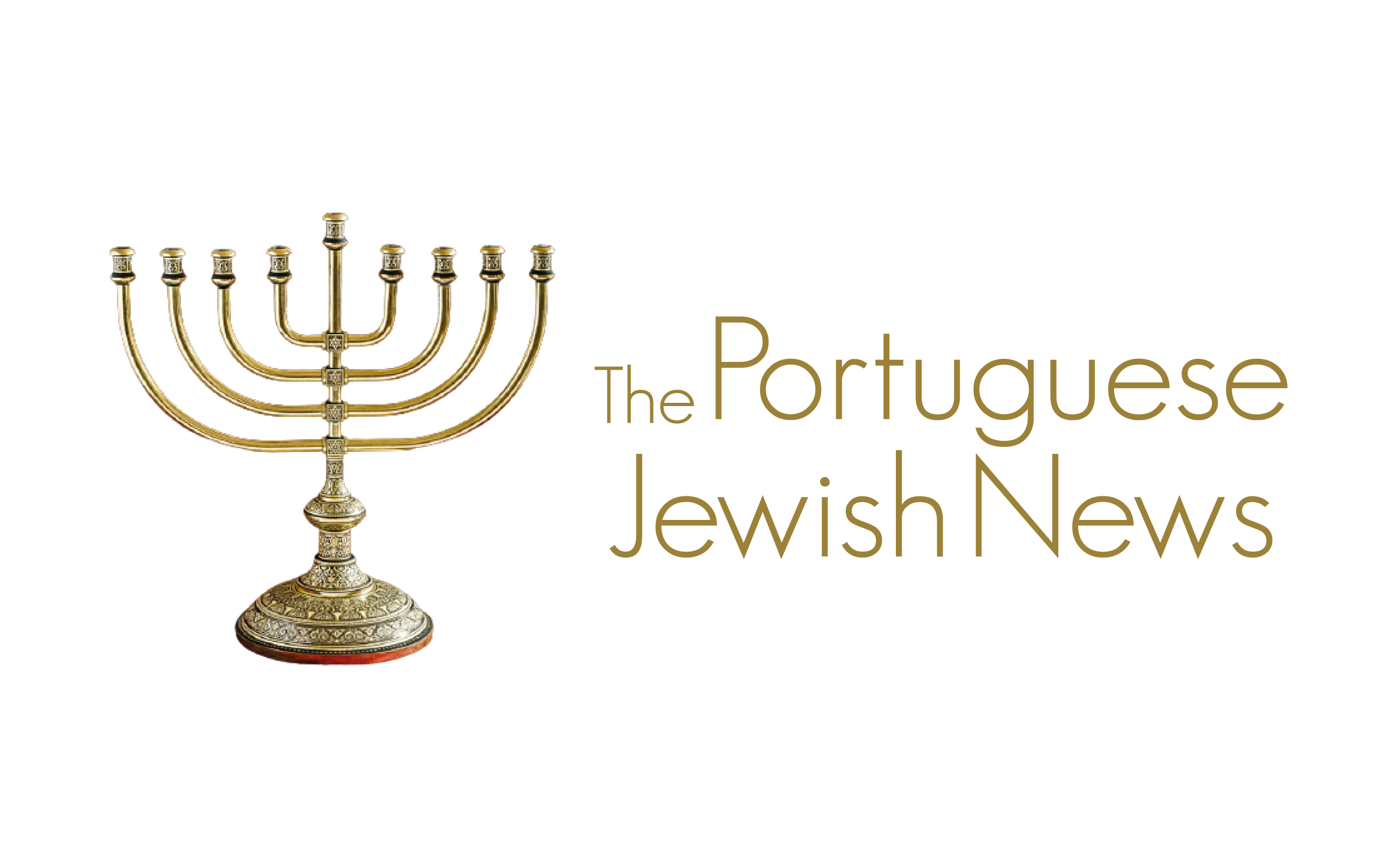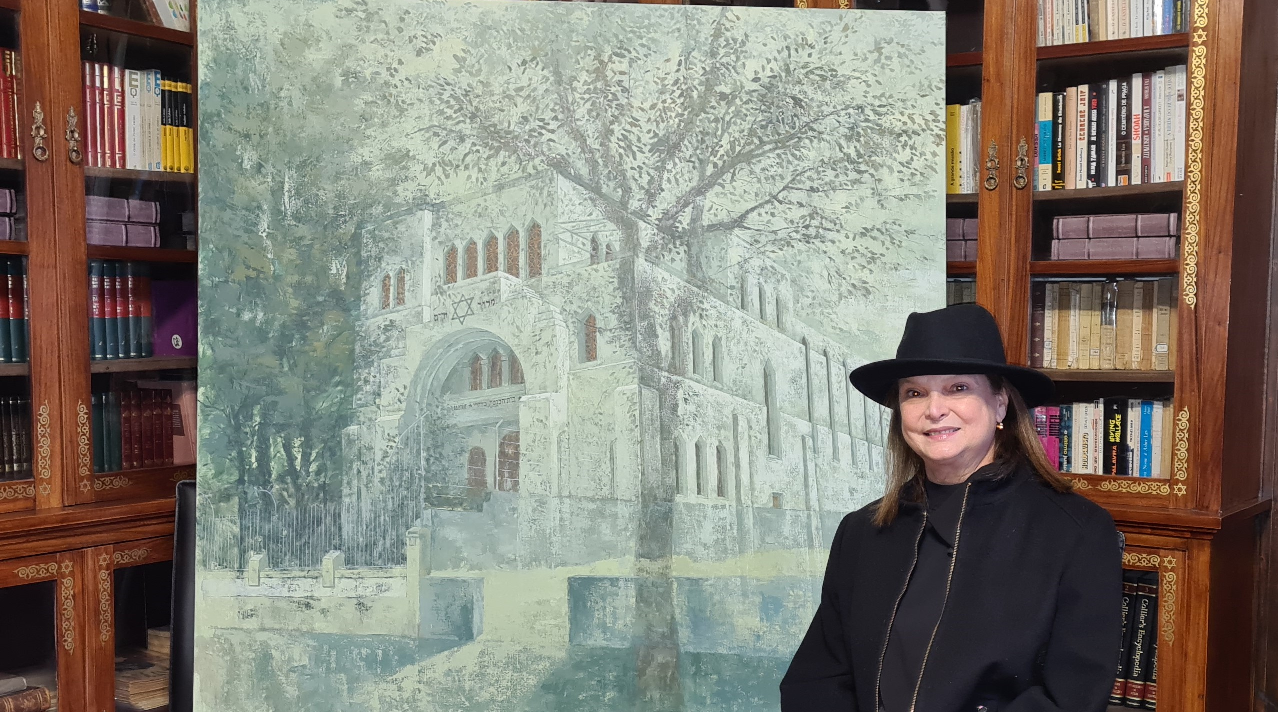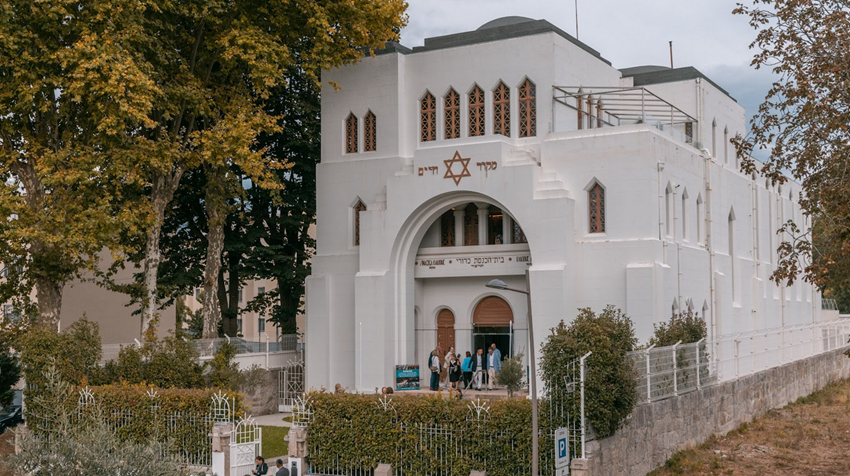The Jewish Museum of Oporto during the celebration of the European Day of Jewish Culture. Credit: CIP/CJP
The Jewish Museum of Oporto, an extraordinary and very beautiful facility, inaugurated in 2019 is dedicated to the history of the Jews in Portugal and in the diaspora. The museum's resources can be explained briefly through its most representative rooms and spaces, but just outside, among gardens and olive trees, two significant memorials stand out: one that recalls the last Gaon of Castile, who died in the city at the end of the fifteenth century, and one that recalls the names of the 842 New Christians from who were persecuted by the Inquisition. A prison wagon from inquisitorial times is also exhibited.

Outside the Museum, a plaque honors the last Gaon of Castile, Rabbi Isaac Aboab. Credit: CIP/CJP
At the entrance to the museum is the welcoming figure of the rabbi, astronomer and mathematician Abraham Zacuto. In the oval room that follows, a journey is made from Abraham and the Seven Noahide Laws to the arrival of the Jews in the Iberian Peninsula, with emphasis on a replica of the Temple of Jerusalem and the Magen David, a Sefer Torah, a chanukiah produced in Toledo based on the ancient art of iron and gold, a statue of Maimonides and the two writings of the great poskim (codifiers) of the Jewish people to this day: precisely the Rambam (from Córdoba) and Yosef Karo (from Lisbon).
In the next space, the names, the fairs and everything that involved in the period before the Manueline edict are exhibited on screens with films, including a huge screen on which the image of what would have been the city then surrounded by walls and which included the old Jewish quarter of Olival is spread. There is also a replica of the epigraph that was once affixed to the synagogue of Monchique. The text clearly reveals the security and trust of the Jewish community in the country's authorities.

A globe and a monitor display the destinations of the Jews after the expulsion. Credit: CIP/CJP
Paintings of superb quality, relating to the foundation, development and decay of the kingdom, are part of the museum collection, highlighting the role of the Jews in the administration of the country that transformed Portugal from a small county to an Empire with 13 million km2. Science, ingenuity, economic resources and an intelligence network abroad were some of the Jewish skills that are highlighted there.
In the part concerning the period of the persecution of the Jews, the visitor can see paintings, books, a globe and a monitor with the destinies of the Jews, as well as the Inquisition they faced throughout the country and in as well. In a large canvas showing the Lisbon massacre of 1506, it was possible to see a wide variety of details: the Convent of São Domingos, a burning pyre burning human remains, the population enraged and armed with sickles as if going to war, Jewish mothers holding their babies before being thrown with them into the bonfires, mutilated bodies on the ground or transported in carts, heads on spearheads, and much more.

Books and objects illustrate the period of the Jewish diaspora. Credit: CIP/CJP
On the consequences of the expulsion of the Jews and the Inquisition to Portugal, the museum exhibition not only addresses the violence that occurred and the aggrandizement of the competing nations to which they went, but also one of the reasons for the tragic defeat of Dom Sebastião in Alcácer-Qibir, well expressed in a rare object exhibited there, called Megillah Purim Sebastiano.
The next part reports on the official abolition of the Inquisition and the immediate arrival in Oporto of Sephardic Jews from Morocco and Gibraltar. An emblematic figure of this exhibition is Jacob Bensabat, the great polyglot of the second largest city in the country at that time. The names of those returned families and the reason why the British banker Moses Montefiori drank kosher Port wine daily until the moment of his death are revealed, as it was certainly produced by that same community.

Barros Basto, the founder of the Jewish Community of Oporto. Credit: CIP/CJP
In the following exhibition, it is revealed how the Ashkenazi community of the city appeared in the late nineteenth and early twentieth centuries and what role was played, in its official recognition, by an officer of the Portuguese army, a hero of the First World War, Captain Barros Basto. The work of rescuing Portuguese marranos attempted by the captain occupies two showcases of the museum, full of information and documents about the living situation and in the light of Jewish law of the Portuguese marranos. A monitor shows part of a community film - "Sefarad" - where the practice of an ancient Marrano ritual is watched in Vilarinho dos Galegos.
The construction of the synagogue and the visit of the Kadoorie family to the city occupy an important part of the museum. It displays a perfect model of the synagogue whose construction began in 1929, and which was inaugurated in 1938. This was one year after the perverse sentence that created the "Portuguese Dreyfus" case. This has its own showcase, with a uniform with the rank of colonel to which Basto would have been entitled if he had not been illegally removed from service. The official documents that prove this well-deserved and never awarded rank (issued by the army in 2013) are also exhibited there.

Photographs and objects highlight the recent history of the Community. Credit: CIP/CJP
The role of Srul Finkelstein (rabbi of the community), Meir Cymerman and Nathan Beigel (presidents of the board) and Henry Tillo (president of the general assembly) are highlighted and remembered in another window, designed for this purpose. Similarly, the role of the directors Emil Oppenheim and Rodolf Lemchen is highlighted in the next part of the museum, based on the incredible story surrounding the death of the former and the kaddish that, in the presence of the latter, a Catholic nun uttered in his memory.
The arrival of refugees from Nazism is also explained in the museum, with images from a film produced by the community, various official documents and a special highlight for Menassé Ben Dov, the leader of the community who supervised the department called "Support to the Exiles".

A room is dedicated to the awards received for the films. Credit: CIP/CJP
The museum is not extensive, but it has a collection of information and documentation that is impressive. There is a movie theater, a kosher Port wine cellar, a room where some of the awards that films produced by the community have received from international festivals are shown, and a room dedicated to the Entebbe operation, which showed the world that, after 2000 years, the Jews once again had a state that could defend them and ensure their safety.
For many reasons, the museum has been described as a work of art. On important dates, the museum has already managed to receive 1000 students from schools at the same time. Ultra-modern in appearance, despite having been built by a private individual in the 1930s, just like the synagogue, that space has not forgotten the development of the Jewish community of Oporto in the 21st century and its action to promote religion, culture and material support to communities in 14 cities around the world.

































